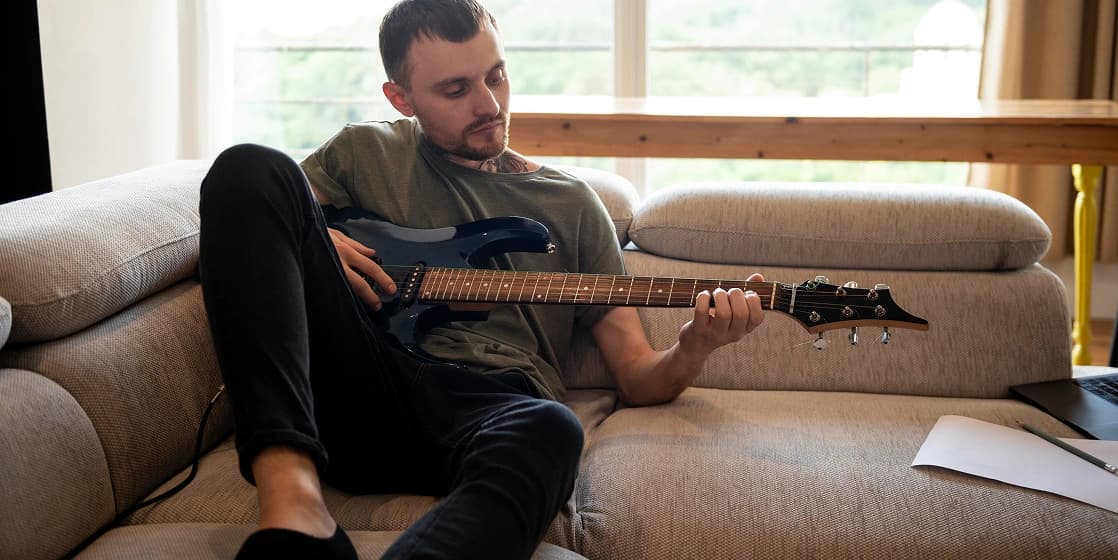Adult Guitar in Apartments: Quiet Gear, Headphones & a 20-Minute Routine



Adult Guitar in Apartments: Quiet Gear, Headphones & a 20-Minute Routine
Learning guitar in an apartment is absolutely doable—without annoying the neighbors. With the right quiet gear, headphones, and a short, repeatable routine, you’ll make real progress and keep the volume down.
At B Amazing Music, our background-checked instructors teach one-on-one, in your home across Winter Garden, Windermere, Lake Buena Vista, Ocoee, Clermont, and Apopka. We’ll match you with a patient guitar teacher, set up your gear, and map a plan you can stick to.
Quick answer (apartment-safe setup)
- Electric guitar + headphones → the quietest, most controllable option.
- Use a headphone amp or small modeling amp with aux-in for backing tracks.
- Choose light strings (0.009–0.042 or 0.009–0.046) and thin/medium picks for softer attack.
- Practice on a chair (not bed/couch) with strap on for stable posture and even dynamics.
- Follow a 20-minute routine (below) 5–6 days/week. Consistency > volume.
Quiet gear that sounds good (no neighbor drama)
1) Electric guitar (best for apartments)
- Lower string tension = easier fretting at low volume.
- Works with headphones and amp sims for convincing tones.
- Consider short-scale models if you have smaller hands.
2) Headphone options
- Closed-back headphones keep sound in and outside noise out.
- Look for comfortable pads and a long cable (or use an extension).
- If you prefer wireless for casual listening, still plug in wired for practice to avoid latency.
3) Amps & interfaces (pick one)
- Headphone amp/amp-in-a-box: tiny, plugs into the guitar, includes amp/cab sounds; simplest.
- Mini modeling amp (10–20W): headphone jack + aux-in for phone/backing tracks.
- Audio interface + laptop/phone app: the most flexible; use amp sim software with headphones.
4) Apartment-quiet accessories
- Rubber pick mute or felt picks for extra-soft strums (optional).
- String dampener (scrunchie/hair tie near the nut) to tame open-string ring during exercises.
- Clip-on tuner for silent tuning.
- Folding stand to keep the guitar visible (more practice = lower volume overall).
Acoustic route? Use silk & steel or extra-light gauge strings and a soundhole plug, but know electrics still win for apartment quiet.
The 20-Minute Adult Routine (copy/paste)
5–6 days/week. Keep it soft and steady. If life gets hectic, do 10 minutes (Parts A–B) and call it a win.
A) Pulse & Warmup — 3 minutes
- Set a metronome 60–70 bpm.
- Open-string down-strums (4 per click) for 60 seconds.
- Left-hand finger taps on one string (1-2-3-4), then back down (4-3-2-1), pp–mp dynamics.
B) Skill Block — 7–8 minutes (choose one path)
- Chord path (strummers):
- Chord-Change Ladder: G→D (30s), D→Em (30s), Em→C (30s).
- Keep strumming hand moving like a clock even during changes.
- Single-note path (riff/leads):
- One-string picking (alternate pick) 60–90s.
- 5-note box (minor pentatonic) at 60 bpm; aim for even volume and no string noise.
C) Music Time — 7–8 minutes
- One slow pass for accuracy (soft dynamics).
- One musical pass with gentle dynamics or palm-mute groove.
- Add backing track at low headphone volume through amp/interface aux-in.
D) Wrap — 1–2 minutes
- Record a 20–30 second clip.
- Write one win (“Em→C clean at 65 bpm”) + tomorrow’s cue (“lighter pick grip”).
Ultra-quiet techniques (they still sound great)
- Palm-mute near the bridge for tight, low-volume rhythm.
- Fingerstyle for mellow tone; rest strokes keep volume controlled.
- Pick grip: hold closer to the tip with a light hand; less plastic hitting strings = less noise.
- Left-hand pressure: fret just behind the metal fret; use the minimum pressure for a clean note.
Apartment etiquette that keeps the peace
- Practice window: choose the same quiet hours daily (e.g., 6:30–7:00 pm).
- Decibel drift: if you can clearly hear yourself outside the door with headphones on, turn down the amp master, not just the guitar volume.
- Vibe check: share your favorite 30-second clip occasionally with neighbors/roommates—most concerns drop when they hear the volume is reasonable.
Troubleshooting (fast fixes)
- String/fret buzz: increase left-hand accuracy (press right behind the fret). Persistent buzz? You may need a setup.
- Noisy changes: keep strumming hand moving and release pressure cleanly between chords.
- Harsh headphone tone: lower gain, raise master output; add slight cab sim or EQ to cut ice-pick highs.
- Hand fatigue: try lighter strings/pick, shorten sessions (10+10 split), shake out hands every 8–10 minutes.
Sample 2-Week Roadmap
Week 1:
- Chord path: G–D–Em–C changes at 60–65 bpm; add down-down-up-up-down pattern.
- Riff path: one-string lines, then 5-note box at 60 bpm; add two-note bends (very lightly).
- Goal: even volume, clean fretting, zero neighbor complaints.
Week 2:
- Chord path: add Am; practice two-bar chord loop with palm-mute.
- Riff path: connect two strings; simple call-and-response over a backing track.
- Goal: one musical clip you’re happy to replay.
Quick buying checklist (budget-friendly)
- □ Electric guitar that fits your hands (consider short-scale if needed)
- □ Headphone amp or mini modeling amp with headphone/aux
- □ Closed-back headphones (comfortable, long cable)
- □ Clip-on tuner, thin/medium picks, light strings (0.009–0.042 or 0.009–0.046)
- □ Guitar strap (even when sitting), folding stand, microfiber cloth
FAQ
Is electric really quieter than acoustic?
Yes. With headphones, an electric is the quietest legit practice setup.
Can I learn on acoustic in an apartment?
You can—with extra-light/silk & steel strings, felt picks, and mindful hours—but electric + headphones is easier.
Do I need pedals?
Not to start. A headphone amp or modeling amp gives you clean, crunch, and reverb without pedals.
Is 20 minutes enough?
Absolutely. Short, frequent sessions build coordination faster than occasional marathon practices.
Want a zero-drama apartment setup—and a plan you’ll actually follow?
We’ll help you choose the quiet gear, dial in headphone tone, and build a 20-minute routine that fits your schedule. Lessons happen in your home with a patient, encouraging teacher.
